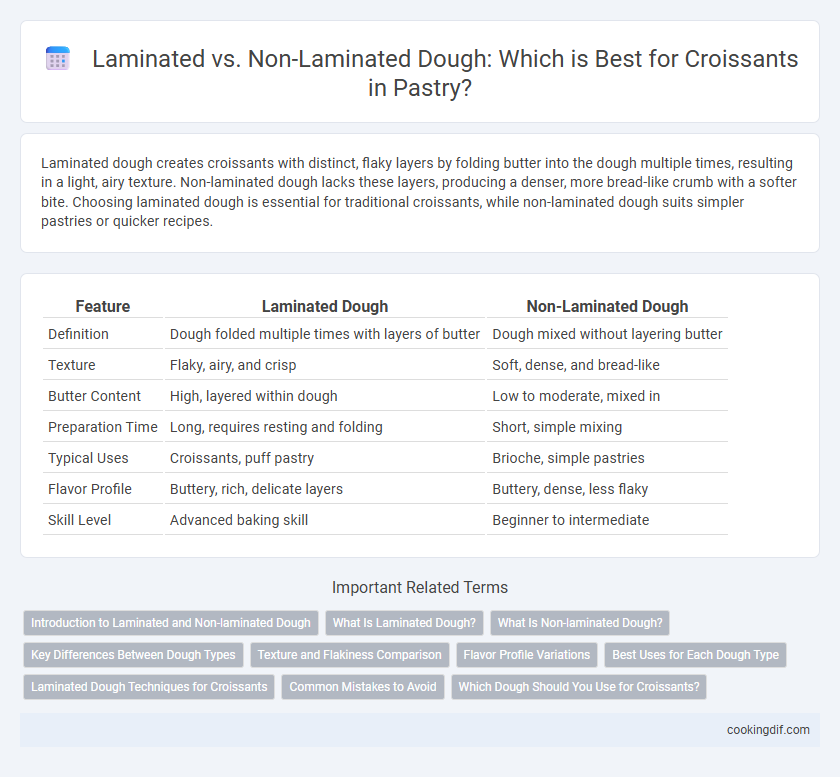Laminated dough creates croissants with distinct, flaky layers by folding butter into the dough multiple times, resulting in a light, airy texture. Non-laminated dough lacks these layers, producing a denser, more bread-like crumb with a softer bite. Choosing laminated dough is essential for traditional croissants, while non-laminated dough suits simpler pastries or quicker recipes.
Table of Comparison
| Feature | Laminated Dough | Non-Laminated Dough |
|---|---|---|
| Definition | Dough folded multiple times with layers of butter | Dough mixed without layering butter |
| Texture | Flaky, airy, and crisp | Soft, dense, and bread-like |
| Butter Content | High, layered within dough | Low to moderate, mixed in |
| Preparation Time | Long, requires resting and folding | Short, simple mixing |
| Typical Uses | Croissants, puff pastry | Brioche, simple pastries |
| Flavor Profile | Buttery, rich, delicate layers | Buttery, dense, less flaky |
| Skill Level | Advanced baking skill | Beginner to intermediate |
Introduction to Laminated and Non-laminated Dough
Laminated dough, essential for croissants, involves folding butter into the dough multiple times to create thin, alternating layers that produce a flaky, airy texture. Non-laminated dough lacks these layers, resulting in a denser, bread-like consistency often used in pastries that prioritize softness over crispiness. Understanding these dough types reveals the distinct characteristics that define classic viennoiserie versus simpler baked goods.
What Is Laminated Dough?
Laminated dough is a type of pastry dough characterized by multiple layers of butter and dough created through a repetitive rolling and folding process, essential for croissant's flaky texture. This method traps steam in the layers during baking, resulting in a light, airy, and crisp pastry. In contrast, non-laminated dough lacks these layers, producing a denser and more bread-like consistency.
What Is Non-laminated Dough?
Non-laminated dough is a type of pastry dough that lacks the multiple folded layers of butter found in laminated dough, resulting in a denser and less flaky texture. Commonly used in pastries like brioche or some coffee cakes, non-laminated dough relies on yeast or chemical leaveners for rising rather than steam produced from butter layers. This type of dough emphasizes tenderness and richness instead of the crisp, airy layers typical of laminated dough varieties such as croissants.
Key Differences Between Dough Types
Laminated dough, used for croissants, consists of layers of butter and dough folded repeatedly to create a flaky, airy texture, while non-laminated dough lacks these layers resulting in a denser, more bread-like crumb. Laminated dough requires precise temperature control and time-intensive folding to achieve its characteristic rise and crispiness, in contrast to non-laminated dough's straightforward mixing and proofing process. The key differences lie in texture, preparation complexity, and final product structure, with laminated dough delivering delicate, buttery layers and non-laminated providing a softer, more uniform bite.
Texture and Flakiness Comparison
Laminated dough for croissants creates multiple thin layers of butter and dough, resulting in a light, airy texture with distinct flakiness and a crisp exterior. Non-laminated dough lacks these layers, yielding a denser, softer crumb without the characteristic crunch or delicate flake. The contrast in texture between laminated and non-laminated dough is pivotal, with laminated dough preferred for its buttery, layered crispness essential to classic croissants.
Flavor Profile Variations
Laminated dough for croissants creates a flaky, buttery texture with rich, layered flavors due to the incorporation of multiple layers of butter and dough. Non-laminated dough yields a denser, bread-like crumb with a more straightforward, yeasty taste, lacking the crisp, delicate layers of laminated varieties. The lamination process intensifies the buttery aroma and enhances the overall complexity of the croissant's flavor profile.
Best Uses for Each Dough Type
Laminated dough, characterized by its multiple butter layers, is ideal for flaky, airy croissants that require a delicate, crisp texture, making it perfect for classic French bakery items and pastries needing a light structure. Non-laminated dough, denser and more uniform, suits croissants filled with rich ingredients or those baked into savory options like ham and cheese croissants, providing sturdiness and better support for fillings. Selecting laminated dough enhances the buttery flakiness of traditional croissants, while non-laminated dough offers versatility for hearty, filling-rich croissant varieties.
Laminated Dough Techniques for Croissants
Laminated dough for croissants involves repeatedly folding and rolling butter into the dough to create multiple thin layers that result in a flaky, airy texture upon baking. Precision in temperature control and dough handling is essential to maintain the butter's consistency and achieve optimal lamination without melting or breaking through the dough layers. Mastering techniques such as turning, chilling, and resting between folds ensures the signature crispness and rise of high-quality croissants.
Common Mistakes to Avoid
Common mistakes when making laminated dough for croissants include overworking the dough, which can cause tough, dense layers, and improper butter temperature, leading to uneven lamination and greasy pastry. For non-laminated dough, a frequent error is failing to properly relax the dough, resulting in a tight texture and less flaky bite. Avoiding these pitfalls ensures croissants achieve the desired flaky, airy structure characteristic of perfect French pastries.
Which Dough Should You Use for Croissants?
Laminated dough is essential for authentic croissants, creating the characteristic flaky layers by folding butter between dough sheets multiple times. Non-laminated dough lacks these layers, resulting in a denser, more bread-like texture unsuitable for traditional croissants. For true croissant texture and flavor, laminated dough is the preferred choice.
Laminated vs Non-laminated Dough for croissants Infographic

 cookingdif.com
cookingdif.com